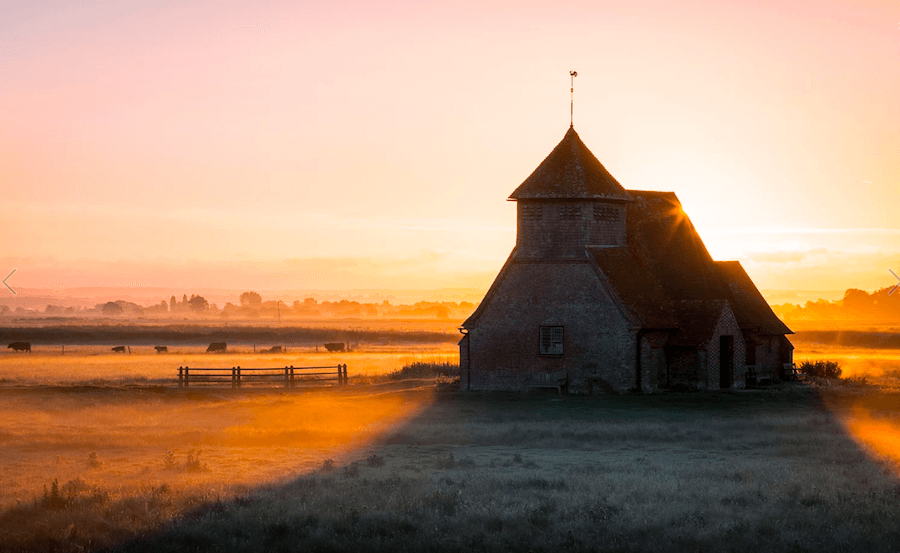
Tucked away on the southern coast of England, Romney Marsh is a wetland area like no other. With its sprawling grasslands, winding rivers and shingle beaches, this remote region of Sussex has an atmosphere of isolation and tranquillity. Though largely uninhabited by humans, Romney Marsh is teeming with diverse wildlife and charming rural villages waiting to be explored.
Romney Marsh was formed by the silting up of a bay over the course of centuries. The lack of drainage on these heavy clay soils created an expanse of flat, marshy fields dotted with ponds and waterways. Once an inlet of the sea, Romney Marsh was gradually cut off by the accumulation of pebbles along the coast, forming a unique landscape.
The Mysteries of Romney Marsh
Romney Marsh has a mysterious origin story that has shaped its landscape over centuries. Around 10,000 years ago after the last Ice Age, this whole area would have been underwater as waters rose. Over time, waves deposited sand and shingle that formed islands along the coast. A barrier of shingle built up between Dymchurch and Dungeness, creating saltwater lagoons behind it. As these lagoons gradually silted up, they transformed into salt marshes.
Looking at a map from around 1200 AD, you can see this growing shingle barrier at the mouth of the sea. Areas of high and low-lying land are visible. The village of Fairfield sits just at the edge of the receding shoreline. In the 12th century, the population was expanding rapidly and more land was needed to produce food. Monks from Christchurch College in Canterbury began draining and reclaiming much of Romney Marsh, turning marshy terrain into productive fields for grazing sheep and growing crops.
But this new land was not without issues. Prone to flooding and swarming with mosquitoes that spread deadly diseases, Romney Marsh was a hazardous place to live and farm. Outbreaks of both the Black Death and malaria, also called marsh fever, devastated the local population in the 14th and 16th centuries. Hundreds of farm workers succumbed while the wealthy landowners on higher ground were less affected. The village of Fairfield was eventually deserted, leaving just the church alone on the marshes.
Around Fairfield Church, long straight ditches were dug by hand to drain the soggy ground. Marsh nights echoed to the eerie calls of smugglers nicknamed Owlers, their doings immortalised by Russell Thorndyke’s fictional character Doctor Syn, an upright Dymchurch vicar by day but smuggler by night.
The wool of the Romney Marsh sheep is thick, dense and high quality; it was in great demand in France during the 17th and 18th centuries. The high Custom and Export Taxes imposed encouraged an illicit trade in the fleeces which were smuggled from the Marsh to France. In 1698 most of the fleeces of the 160,000 sheep shorn on the Marsh were smuggled to France.
What to See and Do in Romney Marsh
Today, Romney Marsh is home to a variety of habitats and wildlife. This patch of pristine wetland near the south east coast covers a whopping 100 square miles and is packed with wildlife – including the curious marsh frogs which you can also hear in the ponds at Whitesand.
Lush grasslands, interspersed with shallow freshwater pools and ditches, provide the perfect environment for ground-nesting birds like lapwings, oystercatchers and skylarks. Here, you can also spot herons, egrets and marsh harriers that nest in these secluded wetlands during spring and summer.
The landscape transitions into more shingle beaches and sand dunes along the coastline of Romney Marsh. Here black-headed gulls, terns, and avocets can be observed in great numbers, especially during migration seasons. Seals also frequent these shorelines during winter months. Rye Harbour Nature Reserve is a prime spot to hike or cycle along these coastal habitats while catching sight of myriad bird species.
Beyond just its ecological diversity, Romney Marsh has a rich human history as well. Its vast grasslands have been used for sheep grazing since medieval times. Many of the quaint villages dotted throughout Romney Marsh, such as Old Romney and Midley, retain their historic rural charm. Local churches built with distinctive spires to act as landmarks are a unique architectural feature.
Planning Your Visit
Romney Marsh offers delightful sights across all four seasons. However, timing your visit right allows you to take part in some truly memorable wildlife spectacles. Spring is a lovely time to observe newborn lambs in the fields with their mothers. Their playful frolicking amid the flower-speckled grasslands is a sign of rebirth each year. Spring is also when migrant birds return to nest in the marsh, bringing plenty of birdwatching opportunities.
Late summer and early autumn provide a chance to see wildflowers in full bloom across the meadows. In late autumn, starlings arrive en masse to roost in the reed beds, creating phenomenal murmuration in the skies at dusk as they twist and turn in harmony before descending to rest. Seals are also more active during the winter months, hauling out on the beaches near Rye Harbour.
No matter when you decide to visit Romney Marsh, its peaceful atmosphere and wealth of nature will rejuvenate your senses. If you’re looking for a change of scenery, why not give the atmospheric Romney Marshes a visit during your stay in one of our coastal cottages?



